Hi,
I am finishing the interior of a new 3-season porch. For the walls I am using 6″ v-groove pine installed verticaly and painted white. I am looking for installation suggestions. The room is a rectangle with the long wall parallel to the house. The walls will have los of window space so side walls will mostly have short boards just below and above the large windows. The house wall has a glass sliding door.The ceiling is open so the outside and Inside long walls will have boards all the way up to the peak.
I was planninog to start the installation in the middle of each wall so that I had an equal width board at each end. But since the room is a rectangle, that could mean I end up with a corner that has, say, one 4 inch wide board and one 2 inch wide board. It doesn’t seem like that would look very good. I’ve thought of the following other options:
- start at each corner and work towards the middle so that each wall has only one narrower board placed in the middle of the room. This puts full boards at each corner but leaves a narrow board in the middle of the long walls where the boards are longer, to extend to the peak, and so the narrow board would stand out more.
- only do option 1 on the outside long wall ; on the side walls work back from the outside corners towards the house. That would put the narrower boards in the less visible inside corners. But. hat still leaves the narrow boards inj the middle of the more visible walls.
- start in the middle of the longer walls so a narrow board is left at each end but then, on the side walls work back with full boards to leave the narrower boards in the less visible corners on the house wall.
If you were installing the pine, how would approach it so it looks the best?
Thanks for any suggestions.
George



















Replies
First off, I'd wonder why you're painting the stuff rather than staining and varnishing.
Then I would point out that T&G planks only "like" being installed in one direction. Unless you face-nail you need to nail at an angle through the tongue, which means you must install each plank on the tongue side of the previously-installed one.
Finally, when you cover a distance of 10-15 feet with T&G planks it's hard to predict where the final plank will be split,due to slight differences in how tight joints are.
I agree with Dan. Starting inthe middle is not likely to give you an equal board in each corner and the tongue / groove issue is a problem although you can deal with it with a spline to reverse diretion. If the wall is "long" you will not notice the different widths in the corners. And you will probably hang stuff on the walls to distract teh viewer from studying the corners.
You sound anal, like me. Well I am not exactly anal, but when I do stuff myself, I lhave the time and ability to go the extra mile for details. But sometime it is not worth it and does not work out the way you planned it as is likely in this case of working with teh variable width of T & G borads
You nailed it - anal. To a fault. First, painting the T&G because I like the look better on the walls and I want the contrast between that and the finished flooring on the ceiling. Did a porch on the previous house where I varnished, prefer the paint on this one. It was a long time ago. Don't know why I didn't worry about the corners then.
As far as the evenness of the cut boards on each end, I hear you but I was trinking I would end up with, say, a 4" board on one end and, say a 4-1/2" board on the other end, rather than a full board on one end and 3" board on the other. The lack of symetry bothers me. Yeah, anal and a bit OCD too.
Since I am painting I am not worried about face nailing. I planned to use a shim to reverse the directionso face nailing will be at a minimum.
For the corners, whatever they are I think I will add a bevel on the edge to match the other joints.
thanks for the sanithy check.
George
It is true ...
You are thinking like a tile setter. When setting tile, technically you are supposed to start with either a full tile or a grout line in teh center of a bath enclosure. Which one depends on which option gives you the larger cut tile in the corners. In so doing each corner has a cut tile or equal width. Now for a five foot enclosure this is likely moer important that a 20 foot wall.
I have seen lazy or cheap tile setters start in the corner and just work accross. I spot it every time.
George,
if you want real close to same at each end, you best start in the middle and use a glued in to the groove spline to change direction. You can get semi close with luck if you start at one end and go across.
Anything more than an inch or two coming out of the corner might not be pleasing but....
using sizes for the corner board that appear to wrap around the corner in the same joined size as your regular boards looks good.
more important to mention is your idea of painting. It's almost impossible to block knot bleed through the finish weather paint or stain. Exterior heat will almost always cause the knots to at least halo. I've done a couple painted and light stained porches out of pine and while the ceilings are more prominent to do this, there's a good chance you'll see some bleed through on the sidewalls. Insulation helps but doesn't stop it.
best of luck.
Regarding bleed through, the boards are pre-primed and it will be insulated. think it is worth hitting knots that I can see through the primer with a stain block like Kilz?
Prime with Kilz?
GeorgeP wrote:
Regarding bleed through, the boards are pre-primed and it will be insulated. think it is worth hitting knots that I can see through the primer with a stain block like Kilz?
Yes